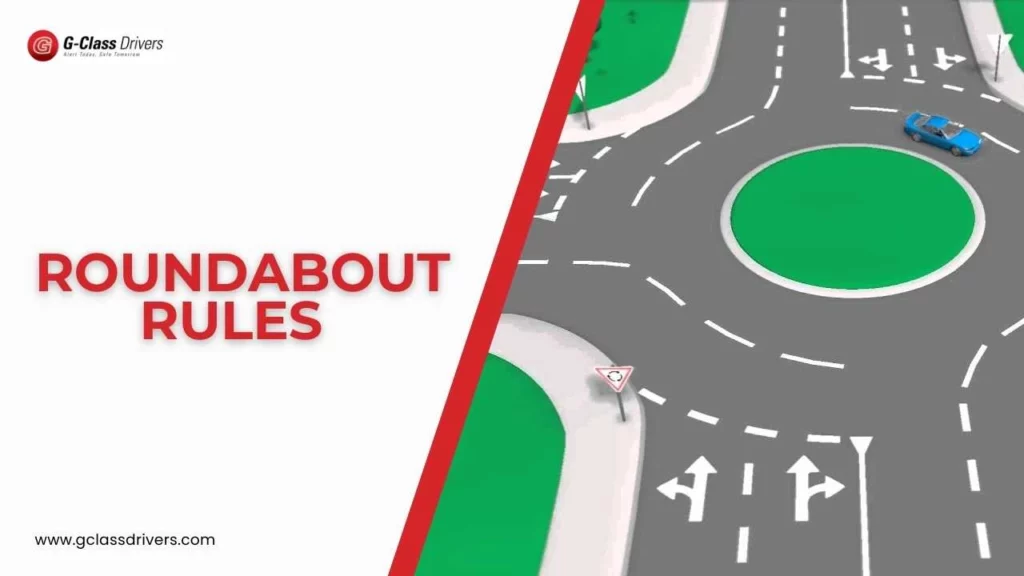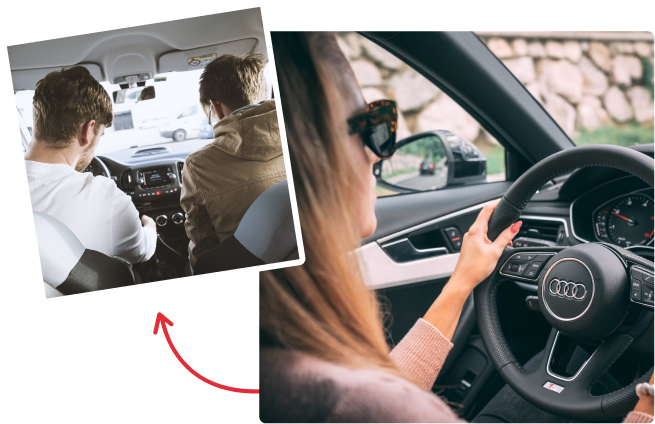When you don’t know the rules, driving in a roundabout can be a little difficult. It’s like a traffic puzzle. But you don’t need to worry, it’s simple to learn. Roundabouts help the traffic flow smooth and reduce the rates of accidents on the road.
In this article G-Class Drivers will guide you to everything about the roundabout that you need to know about roundabout rules, from simple to tricky rules. After reading this article, we assure you that you feel much more confident about how to drive in roundabout
What is Roundabout?
Roundabouts are circular intersections where two or more roads come together. Traffic flows easily around these roundabouts in a circle counter-clockwise around a central part. What is a roundabout designed for? Roundabouts are created to make crossing points more efficient and more secure for drivers, cyclists and walkers as well.
Countries like Canada, especially Ontario, use roundabouts over common stop lights as they are more affordable to work (no need for installation and maintenance of sign lights). Roundabouts can have a range of 1 to several paths, depending on how much traffic flows in that area. When it comes to 2 lane roundabout rules, the key is to pick your lane carefully before entering and avoid changing lanes while in the roundabout.
The most important is that studies show that by using roundabouts there is less chance of serious accidents. Roundabouts protect from serious injuries which helps in reducing the number of car insurance in Ontario.
Rules of the Roundabout
When you reach a roundabout, there are some rules you must follow, in order to prevent any accidents. Here’s the information of how to use a roundabout:
Approach:
- Decrease your speed and watch the roundabout signs.
- If there’s a multi-lane roundabout, pick your lane on the basis of your expected exit.
- Also, Watch the walkers and cyclists and be prepared to stop at the crosswalk.
- Give Signal left or right to warn different drivers if you want to turn any side at the roundabout (give no sign if you want to continue straight through the roundabout).
Yield:
Wait for some time to find a safe gap in traffic. Remember that drivers in the roundabout have the right of way.
Enter:
- In order to stay at the right side enter the roundabout by turning right.
- Proceed counter-clockwise until you reach your expected exit.
Exit:
- Use your right turn signal before leaving.
- It is important to keep in mind to watch the walkers and cyclists and be prepared to stop at the crosswalk.
These simple rules help to ensure that driving in roundabout areas is safe and useful for everyone.
Roundabout signs
We will explore some roundabout signs which are helpful for you when you approach a roundabout:
Yield Sign
Yield is one of the main signs at roundabouts. This sign guides drivers to yield to traffic that is already circulating in the roundabout. It is important to pay attention to yield signs, the reason is that failing to yield can increase accidents.
Roundabout Ahead Sign
This sign alerts drivers when they reach the roundabout. It gives you a warning to be prepared for the next intersection and properly adjust your speed.
Directional Signs
Once you’re in the surroundings of a roundabout, you’ll see directional signs that show which exits go to different locations. These signs include arrows and may include exit numbers or names of streets, which helps to plan your route more easily.
Exit Signs
These signs show the possible exit available at the roundabout. These rectangular signs commonly list the locations that are related to each exit. It allows drivers to make good decisions for their routes.
Lane Use Signs
In multi-lane roundabouts, lane use signs are important for guiding drivers on which lane they use for their expected exit. These signs can help to stay away from any confusion and keep the traffic flow smooth.
Benefits of Roundabouts
Roundabouts not only to keep the traffic in flow but it also gives many others safety and environmental advantages too. Here are some main benefits of the roundabout:
- Less Accidents: Roundabouts reduce the risk of high speed and accidents rates. Flowing of traffic at lower speeds can result in less serious accidents.
- Improved Traffic Flow: Roundabouts can erase the need for stop signals, traffic lights, and limit delays. It keeps the traffic moving and reduces the chances of traffic jams.
- Environmental Effect: Roundabouts keep the traffic moving, which gives benefit in the less consumption of fuel.
Difference Between Roundabouts and Traffic Circles
The key difference between roundabouts and traffic circles is given below in the table:
| Conditions | Roundabouts | Traffic Circles |
| Size | Mostly larger than traffic circles. | Commonly smaller and often found in residential areas. |
| Traffic Control | Entry is controlled by yield signs, no stop signs. | May have stop signs or traffic signals at entries. |
| Traffic Flow | Designed for continuous flow with lower speeds (15-25 mph). | Traffic may enter at higher speeds (30 mph or more). |
| Lane Changes | Drivers should not change lanes while in the roundabout. | Lane changes can occur within the circle. |
| Accident Types | Reduces potential for T-bone and head-on collisions. | Can lead to right-angle and left-turn collisions due to higher speeds and fewer controls. |
| Usage Context | Commonly used at busy intersections and main roads. | Mostly used in residential and low-traffic areas. |
Final Thought
Roundabouts are becoming popular due to their safety and facility benefits. Understanding roundabout rules and knowing how to drive in roundabout situations is important for any driver. Whether it’s a simple 1 lane roundabout or a 2 lane roundabout, these traffic circles are designed to keep the roads safer and more useful.
Next time when you approach a roundabout, remember the rules for a smooth drive, use the right signals, and always yield to coming traffic.
G-Class Drivers School ensures you master driving skills, including how to navigate roundabouts confidently. Our expert instructors offer step-by-step guidance for smooth and stress-free driving.
Sign up today and learn to drive with confidence and safety in mind!
FAQs
What are roundabouts called?
These junctions are sometimes called Modern Roundabouts, in order to emphasize the distinction from older circular junction types which had different design characteristics and rules of operation. In the United States, those older designs are commonly referred to as “rotaries” or “traffic circles”.
Which vehicle has the right of way at a roundabout?
Drivers entering a roundabout must yield to traffic already in the roundabout. If there are no vehicles in the roundabout you may enter without yielding. Do not change lanes in a roundabout. Use your turn signal to indicate you are exiting a roundabout.
What are the rules for 3 exit roundabouts?
If there are three exits on a roundabout and three lanes, each lane corresponds to an exit, with the first exit being the lane furthest to the left. The second exit is the middle lane, while the third is the lane on the right.
What is the 12 o’clock rule at roundabouts?
If the exit is positioned before ’12 o’clock’ on the roundabout sign, you’ll need the left-hand lane. This is usually for turning left or going straight on, but not always. If the exit is positioned after ’12 o’clock’ on the roundabout sign, you’ll need the right-hand lane.
What is the Rotunda rule?
Drivers entering a roundabout or rotunda must yield the right of way to vehicles already circulating within it. This rule is in place to ensure smooth traffic flow and prevent accidents. In the Philippines, traffic laws enforce this rule to maintain order and safety on the roads.





